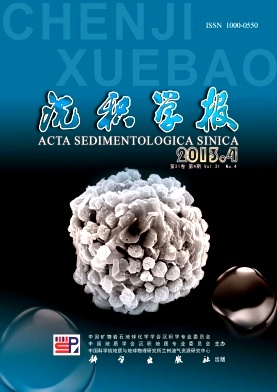Petrogenesis and Sedimentary Environment of Permian Wujiaping Formation Siliceous rocks in Lichuan, Southwestern Hubei
- Publish Date: 2013-08-10
-
Key words:
- siliceous rocks
Abstract: The Upper Permian siliceous rocks of Wujiaping Formation develop in Lichuan, southwestern Hubei. Containing radiolarian and sponge, the siliceous rocks appear with stone coal and volcanic claystone. The radiolarian assemblage is dominated by Spumellaria, followed by Entactinaria and rarely Latentifistularia, which represents the outer shelf environment. The siliceous rocks are rich in terrestrial elements (for example Al, Ti), poor in hydrothermal elements (such as Fe, Mn). Their Al/(Al+Fe+Mn) values are 0.64~0.83, with an average of 0.73. In the Al-Fe-Mn ternary, chert samples locate in or close to Non-Hydrothermal siliceous rocks region. In SiO2- (K2O+Na2O), SiO2-Al2O3, (K2O+Na2O)-Al2O3 binary discrimination diagram, samples plot in or near volcano-sedimentary region. Comparing with abundance of trace elements in sedimentary rocks, life elements: Mo and V assemble, hydrothermal elements: Ba, As, Sc deplete. ∑REE is lower and average ΣLREE/ΣHREE is 3.02, with Ce (δCe:0.75~0.83, average 0.79) and Eu (δEu: 0.61~0.95, average 0.84) slight negative anomaly. Their NASC-normalized REE distribution patterns are nearly horizontal. These geochemical characteristics prove that siliceous rocks are formed by volcano sedimentation with biological effect. Redox indexes: U/Th, V/(V+Ni) and Ceanom, sedimentary environment indicators: MnO/TiO2, LaN/YbN and discrimination diagrams: 100×TFe2O3/SiO2-100 Al2O3/SiO2, TFe2O3/(100-SiO2)-Al2O3/(100-SiO2), TFe2O3/TiO2-Al2O3/(Al2O3+TFe2O3), LaN/CeN-Al2O3/(Al2O3+TFe2O3) and ΣLREE/ΣHREE-100×Eu/ΣREE comprehensively make sure that the siliceous rocks deposited in continental shelf under anoxic condition.
| Citation: | Petrogenesis and Sedimentary Environment of Permian Wujiaping Formation Siliceous rocks in Lichuan, Southwestern Hubei[J]. Acta Sedimentologica Sinica, 2013, 31(04): 590-599. |






 DownLoad:
DownLoad: